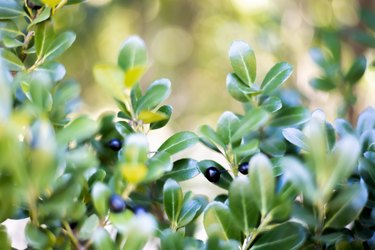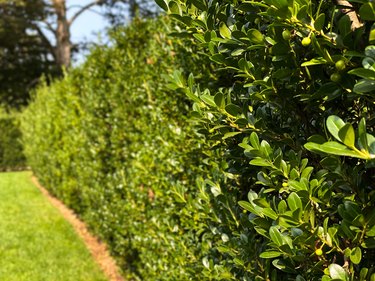Evergreen shrubs help give a garden landscape year-round color, even during winter when deciduous plants drop their leaves and flowering perennials and annuals die back. Holly bushes (Ilex spp.) are especially attractive shrubs with shiny dark green leaves that cover the plants densely along with berries that adorn female plants. The Japanese holly (Ilex crenata) is a holly variety that thrives in USDA plant hardiness zones 6 through 8. It responds well to pruning for shape and size control, but it needs to be done at the right time of year.

Video of the Day
Getting to Know Japanese Holly Shrubs
If you're used to American or English hollies with their prickly leaves and bright red berries, you may not even recognize Japanese hollies. The leaves are smaller, and overall, it has a closer resemblance to boxwood (another popular choice for hedges and foundation plantings). They also bear black fruit rather than red, so you won't enjoy quite the same show of holiday-season color as you'd get with traditional hollies; its winter interest is confined to its foliage and shape. It may be more helpful to think of it as an alternative to boxwood—one that's faster-growing and less susceptible to pests and disease.
Video of the Day

Japanese hollies favor full sun, but most cultivars can tolerate partial shade reasonably well. They prefer a slightly acidic soil with good drainage but can still thrive in less favorable soils—even clay soils—if that's what you have.
Soil drainage can be addressed if necessary by amending the clay with sand and organic material, and alkaline soils can be amended with sulfur to lower their pH. They show some drought tolerance but do require supplemental watering in extremely dry conditions. They're also disease-resistant and generally low maintenance overall, though you'll need to be alert for a few pests, such as spider mites and the holly leaf miner.
The Japanese holly has small, spineless leaves densely covering its branches and produces small white flowers that aren't especially eye-catching for humans but do attract pollinators while the bloom time lasts.
Depending on the specific cultivar you choose, it can spread horizontally like a creeping juniper, form a relatively standard-shaped compact shrub for hedges, take on a strikingly tall and narrow columnar shape (Sky Pencil hollies can be 6 feet tall but only a foot in diameter) or even have a weeping growth habit. All Japanese hollies have a moderate growth rate at less than a foot per year, but it still won't take them long to begin looking unkempt if they aren't pruned.

When and How to Prune Japanese Holly
The best time to prune a Japanese holly is in the late spring/early summer when it's just coming out of dormancy and resuming its growth. Everywhere you prune, the plant will respond with vigorous new growth from buds behind the cut, which gives the shrub a fuller and bushier appearance. (That's why you wait until it's ready to put out new growth.) Avoid pruning the plant in fall or winter because as an evergreen, it may be only partially dormant. If winter-pruned during the cold weather, the shrub might be stimulated to produce new growth that could later be damaged during a period of especially cold weather.
Leaving aside special cases like topiary (they work well for that), there are two main reasons to prune your Japanese hollies. One is to thin their interior growth, giving them a vigorous, airy framework of strong branches to support their foliage. The second reason is cosmetic considerations, primarily controlling your holly's shape and size.

1. Pruning Japanese holly to thin the interior
If you have a recently planted Japanese holly, thinning the plant during its first few years can help promote a densely branched shrub that looks satisfyingly full and bushy. Start by closely examining the holly's existing branches and identifying the ones that are strongest and best positioned. Then, thin it by choosing and removing the extraneous branches entirely, cutting near the plant's main stems. This stimulates the plant to put out several new branches at each cutting point.
After the first two or three years, you can stop thinning and head back the entire plant by shortening the length of all of its smaller branches by about one-third. Several new shoots usually form at each cutting point, keeping the total plant dense and attractive as it fills back in. Keep in mind the general rule of not taking more than a third of the plant's branches in a given year.
2. Pruning Japanese holly for shape and size
Japanese holly does well in mass plantings, most often as a formal hedge. You'll need several plants sited in a row with about 4 feet between each plant (fewer if you opt for a more cylindrical cultivar) to make a perimeter around the space you're looking to define.
To complete the classic look of a hedge, lightly trim your hollies to flatten them at the top using hedge trimmers or hand shears. You can trim the sides to be vertical or trim them at a slight camber so they narrow toward the top. For a neat appearance, periodically trim back any thin, stray shoots that protrude from the plant's surface. If you've thinned the plant earlier in the season, postpone shearing until new growth appears—but don't shear the plant after mid to late summer to avoid the winter-burn of new growth.

You can also shape stand-alone specimens with your clippers or shears, forming them into balls, tapered cones or any other shape that appeals to you. Keep your cuts as shallow as you can while still creating the shape you want because that way, as the newly cut tips branch out, they'll create thick growth at the surface of your shrub.
3 Tips for Pruning Japanese Holly
1. When pruning a Japanese holly bush, disinfect your pruning blade or the blades of your hedge trimmer by wiping them thoroughly with rubbing alcohol between cuts to discourage the spread of plant diseases.
2. Use bypass shears and loppers rather than the anvil type to make clean cuts and avoid damaging the plant.
3. After pruning, keep the plant well watered to encourage new growth and add a 2- to 3-inch layer of organic mulch under the bush. Mulching helps conserve soil moisture and keeps down competition from weeds for soil nutrients.